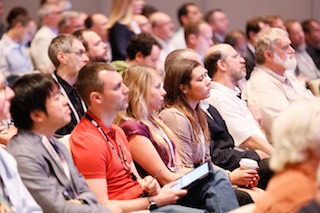 The Society of Motion Picture and Television Engineers has announced conference program details for the SMPTE 2016 Annual Technical Conference & Exhibition, being held October 25-27 in Hollywood, California. During SMPTE 2016, conference sessions will feature industry experts from around the world, who will present 73 papers exploring timely, compelling topics that are shaping the field of motion imaging.
The Society of Motion Picture and Television Engineers has announced conference program details for the SMPTE 2016 Annual Technical Conference & Exhibition, being held October 25-27 in Hollywood, California. During SMPTE 2016, conference sessions will feature industry experts from around the world, who will present 73 papers exploring timely, compelling topics that are shaping the field of motion imaging.
"The SMPTE 2016 program committee evaluated more than 170 technical papers for relevance, innovation, and educational value to the creative and technological communities serving the motion-imaging industry," said Paul Chapman, SMPTE 2016 conference chair. "We are confident that the resulting conference program is captivating and worthy of SMPTE's centennial year."
In addition to Chapman, program committee members for SMPTE 2016 include co-chair Jim DeFilippis; SMPTE education vice president Patrick Griffis; SMPTE executive vice president Matthew Goldman; SMPTE governors Siegfried Foessel, Sara Kudrle, and John Maizels; SMPTE past president Peter Ludé; and SMPTE members Harvey Arnold, Thomas Edwards, John Ferder, Bill Hogan, Al Kovalick, Vicki Lau, David Long, Kellie McKeown, Peter H. Putman, Arjun Ramamurthy, Bill Redmann, Kevin Stec, Chris Witham, Steve Wong, Jennifer Zeidan, and Mark Zorn.
Papers will address ultra-high-definition and 4K/8K resolution, higher frame rates, high dynamic-range, and wider color gamut in sessions that examine how these aspects impact and align with the director's original creative intent. The Future of Cinema sessions will focus on delivering higher-contrast HDR images and increasing pixels per second by delving into the aesthetics of HFR capture, the psycho-visual effects of HFR presentation, and the impact achieved by overfilling one's field of view. Sessions dedicated to color management likewise focus on HDR while examining the art and science of preserving and enhancing creative intent. Presentations on display technologies will address the challenges of developing test patterns to evaluate and calibrate UHD HDR displays and also discuss the use of the 60 GHz radio spectrum to provide wireless high-bandwidth display connections.
Two sessions on new distribution modalities will discuss challenges in transmitting immersive-quality video for over-the-top services and the influence of digital technology on distribution channels. In sessions on video compression, presenters will discuss both ends of the spectrum: low-bandwidth usage for OTT internet delivery to mobile devices and mezzanine encoding for high-end, intra-, and inter-studio/facility applications.
Sessions on broadcast infrastructure will explore the nature of continued broadcast signal distribution over coaxial cable and discuss the evolution of serial digital interface (SDI), including its potential to deliver 100 Gigabit services and enable a seamless transition to internet protocol. Moving into the cloud, conference sessions will focus on how broadcast media-processing capabilities can be migrated to an IP architecture and virtualized across a data center and cloud infrastructure for encoding, master control, disaster recovery, and archiving.
Sessions will explore how standards, quality checks, and best practices can be counted on to protect, and even improve, the audience's experience with VR. Speakers will present challenges, solutions, and metrics for VR workflows and content interchange, and they will review techniques to increase reliability and ensure the quality of VR productions.
Content security is an ongoing concern for the motion-imaging industry, and SMPTE 2016 conference sessions will investigate the security of Interoperable Master Format, particularly in the cloud, and the challenges of watermarking UHD/HDR content.
In the SMPTE 2016 session Reinventing Entertainment Engineering: Merging the Experience of Today With Millennials' Vision for Tomorrow, six millennials in entertainment engineering will deliver presentations on their experiences, outlooks, and hopes for the future — on what it means to be a millennial in the motion-imaging field today. This session will provide insight and feature an interchange on attracting and retaining young engineers to sustain the vitality and future of the entertainment industry. The session will provide ample time for audience questions.
Further details about SMPTE 2016 are available at www.smpte2016.org.
